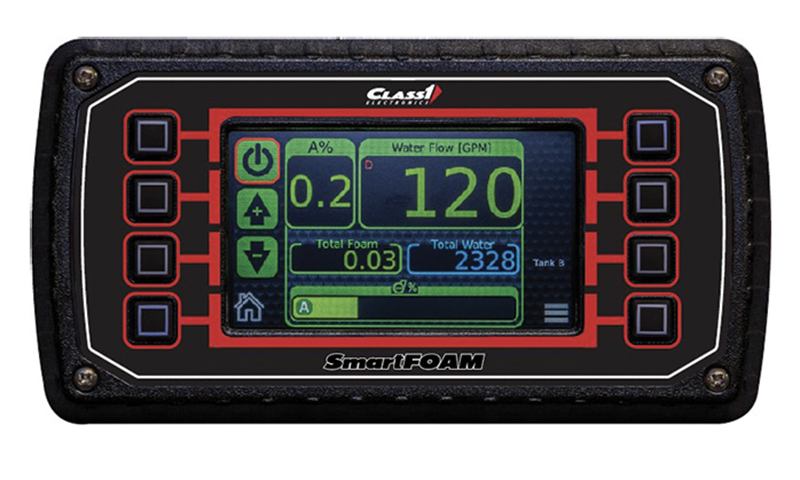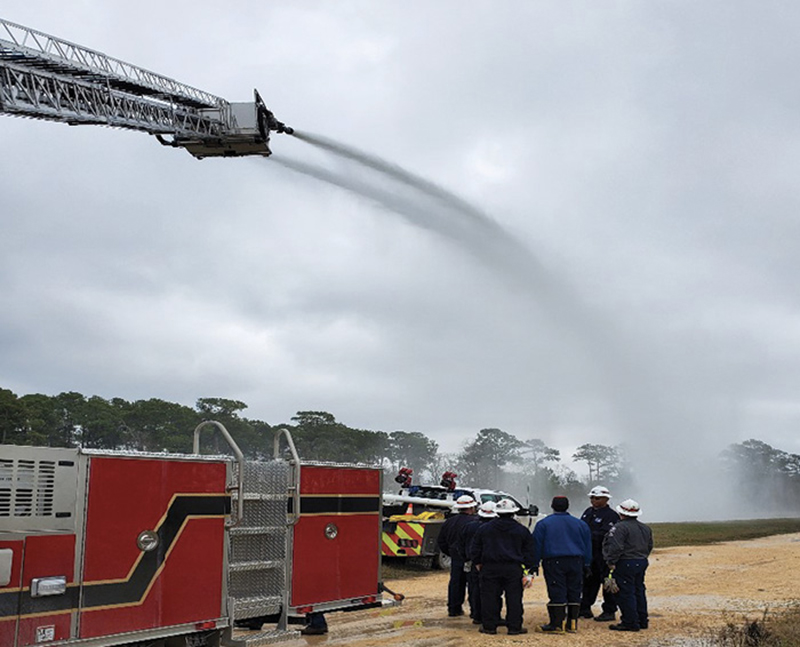
Industrial firefighters face big challenges when dealing with massive amounts of flammable products, so the rigs they use typically carry a big foam system.
Foam examples include the Williams Hot Shot II, FoamPro AccuMax® Fury™ and Fusion™, Hale SmartFOAM, Waterous AQUIS™ ULTRAFLOW, Pierce Husky, and Rosenbauer HYDROMATIC foam systems.
- Selecting the Right Foam
- Training with Foam
- Foam, Foam Concentrate, and Delivery
- Wildland Fire Apparatus Foam Systems
- Preventing Foam Operation Failures, Part 1
- Preventing Foam Operation Failures, Part 2
- Compressed Air Foam Systems Continue in Popularity in Some Wildland Jurisdictions
Williams Fire & Hazard Control
James Morgan, applications and engineering manager for Williams Fire & Hazard Control, says his company’s Hot Shot II Foam System combines the proven reliability of balanced pressure technology with the modern efficiency of a hydrostatic drive powered from the chassis transmission via a power takeoff (PTO). Morgan says Hot Shot II is a hydraulically driven demand system that uses a positive displacement foam pump and pressure control circuit to provide foam concentrate supply at a pressure balanced or matched to that of the fire water pump.

1 The control panel for the Williams Fire & Hazard Control Hot Shot II foam system. (Photo 1 courtesy of Williams Fire & Hazard Control.)
The combination of the pressure control circuit and the variable displacement hydraulic drive system regulates and adjusts the foam pump output, independent of engine or PTO speed, to maintain the proper pressure balance as foam concentrate demand increases or decreases to meet total foam solution discharge requirements, he says. Based on specific installation chassis transmission, PTO drive ratio, and hydraulic drive pump/motor sizing, maximum foam pump output may be achieved at or near engine idle speeds, Morgan notes.
Williams offers a dozen versions of the Hot Shot II Foam System in both single-tank and dual-tank control models. Its ratio controller kits, which include the ratio controller, metering valve, and foam check valve, run from 2-inch to 8-inch ratio controller sizes and can include remote metering controls.
Williams also makes the WATP 500, which can proportion Class B foam up to 4,000 gallons per minute (gpm) at 1% foam proportioning, the Around the Pump 1500 that will proportion Class B foam at up to 4,500 gpm at 1% foam solution, and the Thunderstorm® that will proportion Class A or B foam with foam concentrate flow rates from 12 gpm to 120 gpm that deliver solution flow rates from 40 gpm to 5,000 gpm.
FoamPro AccuMax Fury and Fusion
Michael Dupay, divisional vice president of marketing for fire, EMS and industrial at Safe Fleet, says Safe Fleet’s FoamPro AccuMax direct injection technology foam system measures water and foam flow and controls the foam flow to inject the precise amount of foam, depending on the operator’s percentage setting. “The foam percentage setting is set for each discharge, allowing the operator to send different amounts of foam concentrate to different discharges or water only to certain discharges,” Dupay observes. “The FoamPro AccuMax system can supply up to 15 discharges.”

2 Safe Fleet’s FoamPro AccuMax Fury direct injection technology foam system can supply up to 15 discharges. (Photo 2 courtesy of Safe Fleet FoamPro.)

3 The control panel for the Hale Products SmartFOAM direct injection foam proportioning system. (Pho>to 3 courtesy of IDEX Fire & Safety/Hale Products.)
Two models of the fully automatic AccuMax system are available, Dupay says, the Fury and the Fusion, “which bring the most advanced technology and innovation to the industry’s easiest to use big water foam system for industrial applications.” Dupay points out the Fury is a standard proportioning control system, while the Fusion uses all the elements of the Fury system in a single operator interface that incorporates Elkhart Brass Company’s electric discharge valve controls.
Fury and Fusion both offer choice of foam percentage at up to 15 discharges, multipoint discharge side injection, no inline restrictions for greater flow, injection pressure of up to 300 pounds per square inch (psi), delivery of up to 300 gpm of foam concentrate, unlimited apparatus placement of the operator control, and calibration and testing capabilities without mixing concentrate, Dupay says.
He adds the operator control unit has an impact-resistant military grade liquid crystal display (LCD) screen that gives high resolution in both sunlight and at night through its day or night modes. “Control screens for each discharge that’s foam capable can be color coded with a hood to match other color coding on hoselines and discharges,” he says.
Hale SmartFOAM
The Hale Products SmartFOAM direct injection foam proportioning system allows for preconfigured situations where the system is set up for different foam percentages depending on the type of fire to be fought. “If it’s a Class A or Class B application, the system can flow from 0.1% to 10% foam concentrate, it can be preset for a 3×6 foam that needs a 6% setting, or the specific setting needed for an alcohol-based fire,” says David Durstine, vice president of strategic fire and government sales for IDEX Fire & Safety.
Durstine notes the SmartFOAM system “has an intuitive interface, a best-in-class color display, advanced safety interlocks, six customizable presets, a selectable user interface, prevents the mixing of Class A and Class B foam types, and is capable of controlling two foam pumps.”

4 Waterous Company makes the AQUIS ULTRAFLOW industrial foam proportioning system. (Photo 4 courtesy of Waterous Company.)

5 A Pierce Husky 300 industrial foam system is typically coupled with a Darley ZSM or 2ZSM pump. (Photo 5 courtesy of Pierce Manufacturing Inc.)

6 The pump control panel on an industrial pumper carrying a Rosenbauer G12 HYDROMATIC foam system and Rosenbauer N130 3,500-gpm industrial water pump. (Photo 6 courtesy of Rosenbauer.)
Durstine says Hale also makes Smart ATP, a SmartFOAM around-the-pump system that is geared toward industrial use. “The Smart ATP system will flow either 125 gpm of foam concentrate or 225 gpm of foam concentrate, delivering 3,000 to 3,500 gpm of finished foam product,” he says. “And users can integrate SmartFOAM and ATP into the Hale Products SAM system, an integrated total water flow control system that manages a vehicle’s pump, tank, intakes, and discharges through a single electronic control screen.”
Waterous AQUIS™ ULTRAFLOW
Mike Weinberg, product manager for Waterous Company, says Waterous makes the AQUIS™ ULTRAFLOW Industrial Foam Proportioning System, a high-capacity, demand-based concentrate proportioning system. “Waterous has seen an increase in customer requests for larger foam systems including 500-gpm systems, along with foam proportioning systems that can achieve percentages greater than 6%,” Weinberg points out. ULTRAFLOW is compatible with all current aqueous film forming foam (AFFF) and nonfluorinated concentrates and uses magnetic flow meters for precision concentrate-to-water ratio control accurate within 2% over the full calibrated concentrate pump operating range, he says.
Weinberg notes that the system’s electronic closed loop measurement and control of the concentrate injection rate relative to water flow allow it to give precise concentrate-to-water ratios at up to 16 independent solution-capable discharges. The system can provide up to 300 gpm of foam concentrate at a maximum operating pressure of up to 300 psi, he adds. The ULTRAFLOW system includes a Tellurus™ HMI touchscreen, a primary system control monitor, a hydraulic pump, a hydraulic motor, a hydraulic oil cooler with temperature controller, a foam concentrate pump and discharge pressure transducer, discharge control nodes, magnetic flow meters, ratio control valves, check valves, and paddlewheel flow meters.

7 Trident Emergency Products makes the 500-gpm Trident model GP500 foam proportioning pump for use in various foam proportioning systems. (Photo 7 courtesy of Trident Emergency Products LLC.)
ULTRAFLOW has a manual override option that bypasses the system to operate the concentrate pump in a fixed concentrate pressure or proportional water pressure, Weinberg says. When the override is active, ratio control valves are unpowered and can be manually operated to adjust concentrate injection into selected discharges.
Pierce Husky
Aaron Zak, product specialist lead for fire suppression at Pierce Manufacturing Inc., says Pierce makes two industrial foam systems, the Husky 300 and the Husky 450. “The Husky 300 is Pierce’s most popular big foam system and is usually coupled with a Darley ZSM or 2ZSM pump,” Zak says. “The Husky 300 can deliver up to 30,000 gpm of foam solution at 1% foam concentrate, 10,000 gpm of foam solution at 3% foam concentrate, and 5,000 gpm of foam solution at 6% foam concentrate, all limited by the maximum water pump and plumbing capacities of the truck.”
Zak points out that the Husky 300 and Husky 450 feature a nonrecirculating automatic pressure system to ensure foam concentrate doesn’t recirculate to the foam tank, a metering valve and ratio controller for every specified discharge that allows full transition from cooling water to foam solution and back, a differential pressure gauge display to eliminate water flow guessing and water pressure concerns, and a digitally-controlled foam proportioning system. The Husky 450 industrial foam system can deliver up to 45,000 gpm of foam solution at 1% foam concentrate, 15,000 gpm of foam solution at 3% foam concentrate, and 7,500 gpm of foam solution at 6% foam concentrate and is typically coupled with a Darley 2ZSM pump.
Rosenbauer HYDROMATIC
Jason Kranz, export inside sales manager for Rosenbauer, says the company makes two industrial size HYDROMATIC foam systems, the G12, which delivers 300 gpm of foam concentrate, and the G8, which delivers 210 gpm of foam concentrate. “The HYDROMATIC is a balanced pressure foam system that features a great deal of automation and interlocks that protect the system and the pump,” Kranz notes. “The system is integrated with our Logic Control System, which will not allow the operator to make a bad choice.”
Chris Kleinhuizen, systems engineer for Rosenbauer, says that the G12 and G8 HYDROMATIC systems are generally paired with the Rosenbauer N130 industrial water pump, which delivers 3,500 gpm; the N110, a 3,000-gpm industrial water pump that delivers 3,000 gpm; and the N80, a 2,250-gpm industrial/municipal water pump. He adds that the HYDROMATIC systems can also be paired with pumps made by Hale Products, Waterous Company, and W.S. Darley & Company.
Trident Emergency Products
Brian Van Daalwyk, sales manager for Trident Emergency Products, says his company’s foam pumps are used in several varieties of foam proportioning systems. “Our foam pumps are made in versions that deliver 30, 60, 120, 160, 200, 300, and 500 gpm of foam concentrate,” Van Daalwyk says. “The 60-gpm, 300-gpm, and 500-gpm models are the ones most popular for industrial use.”
Van Daalwyk adds with the changes to non-PFAS type firefighting foams, many users are switching to larger foam pumps. “Many customers have switched from 300-gpm to 500-gpm foam pumps because of the new foams,” he says. “They have found they need to go to the higher foam concentrate gpm to get the same application effect that they got from 300 gpm with PFAS-based foams.”
ALAN M. PETRILLO is a Tucson, Arizona-based journalist, the author of three novels and five nonfiction books, and a member of the Fire Apparatus & Emergency Equipment Editorial Advisory Board. He served 22 years with the Verdoy (NY) Fire Department, including in the position of chief.

